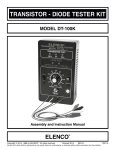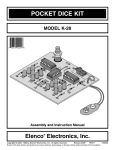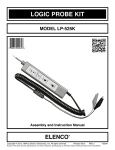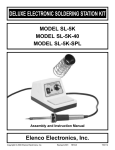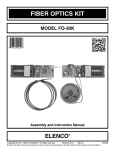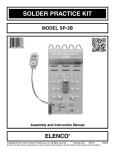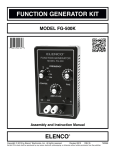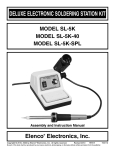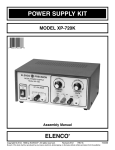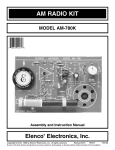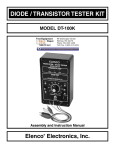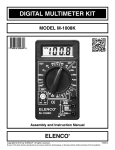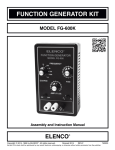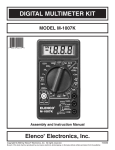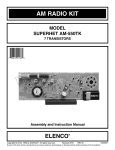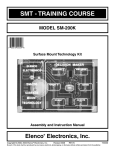Download Elenco Electronics M-1005K Instruction manual
Transcript
SOLDER PRACTICE KIT MODEL SP-1A Assembly and Instruction Manual Elenco Electronics, Inc. ® Copyright © 2009, 1994 by Elenco® Electronics, Inc. All rights reserved. Revised 2009 REV-O No part of this book shall be reproduced by any means; electronic, photocopying, or otherwise without written permission from the publisher. 752601 PARTS LIST If you are a student, and any parts are missing or damaged, please see instructor or bookstore. If you purchased this kit from a distributor, catalog, etc., please contact Elenco® Electronics (address/phone/email is at the back of this manual) for additional assistance, if needed. DO NOT contact your place of purchase as they will not be able to help you. RESISTORS Note: Please refer to page 13 for the resistor reading exercise. This will familiarize you with the resistor color band coding. Qty. Symbol Value Color Code Part # r 1 R3 68Ω 5% 1/4W blue-gray-black-gold 126800 r 2 R1, R7 470Ω 5% 1/4W yellow-violet-brown-gold 134700 r 1 R2 1kΩ 5% 1/2W brown-black-red-gold 141001 r 2 R8,R9 10kΩ 5% 1/4W brown-black-orange-gold 151000 r 2 R4, R6 22kΩ 5% 1/4W red-red-orange-gold 152200 r 1 R5 47kΩ 5% 1/4W yellow-violet-orange-gold 154700 r 2 R4A, R6A 56kΩ 5% 1/4W green-blue-orange-gold 155600 r 1 VR1 200Ω Trim Pot 191321 CAPACITORS Qty. r2 r3 r1 Symbol C4, C5 C1, C2, C3 C6 Value Description .02μF (203) or .022μF (223) Discap 10μF Electrolytic (Lytic) 100μF Electrolytic (Lytic) Part # 242010 271045 281044 SEMICONDUCTORS Qty. r2 r1 r2 Symbol Q1, Q2 IC1 LED1, LED2 Value 2N3904 555 or 1455 Red Description Transistor NPN Integrated Circuit (Timer) LED (Light Emitting Diode) Part # 323904 330555 350002 Qty. r1 r1 r1 r1 r3 r1 Symbol Description PC Board Solder Wick Battery Snap Speaker Wire 22AWG Topcoat Blue 12” (save one piece for the speaker assembly) Solder Tube Lead-free MISCELLANEOUS PARTS IDENTIFICATION Resistors Miscellaneous Semiconductors Capacitors 1/4W Battery Snap 1/2W Integrated Circuit (IC) 8-pin Trim Pot Transistor Electrolytic Discap LED Speaker -1- Part # 511500 556000 590098 590102 814600 9LF99 IDENTIFYING RESISTOR VALUES Use the following information as a guide in properly identifying the value of resistors. BAND 1 1st Digit Color Black Brown Red Orange Yellow Green Blue Violet Gray White BAND 2 2nd Digit Digit 0 1 2 3 4 5 6 7 8 9 Color Black Brown Red Orange Yellow Green Blue Violet Gray White Multiplier Digit 0 1 2 3 4 5 6 7 8 9 Color Black Brown Red Orange Yellow Green Blue Silver Gold Resistance Tolerance Multiplier 1 10 100 1,000 10,000 100,000 1,000,000 0.01 0.1 Color Silver Gold Brown Red Orange Green Blue Violet Tolerance ±10% ±5% ±1% ±2% ±3% ±0.5% ±0.25% ±0.1% BANDS 2 1 Multiplier Tolerance IDENTIFYING CAPACITOR VALUES Capacitors will be identified by their capacitance value in pF (picofarads), nF (nanofarads), or μF (microfarads). Most capacitors will have their actual value printed on them. Some capacitors may have their value printed in the following manner. The maximum operating voltage may also be printed on the capacitor. Electrolytic capacitors have a positive and a negative electrode. The negative lead is indicated on the packaging by a stripe with minus signs and possibly arrowheads. Multiplier For the No. 0 1 2 3 Multiply By 1 10 100 1k Second Digit First Digit Warning: If the capacitor is connected with incorrect polarity, it may heat up and either leak, or cause the capacitor to explode. 4 5 8 10k 100k .01 Means Pico nano micro milli unit kilo mega 0.1 Multiplier 103K 100V Tolerance* Maximum Working Voltage The value is 10 x 1,000 = 10,000pF or .01μF 100V Polarity Marking * The letter M indicates a tolerance of +20% The letter K indicates a tolerance of +10% The letter J indicates a tolerance of +5% Note: The letter “R” may be used at times to signify a decimal point; as in 3R3 = 3.3 METRIC UNITS AND CONVERSIONS Abbreviation p n μ m – k M 9 Multiply Unit By .000000000001 .000000001 .000001 .001 1 1,000 1,000,000 Or 10-12 10-9 10-6 10-3 100 103 106 -2- 1. 1,000 pico units = 1 nano unit 2. 1,000 nano units = 1 micro unit 3. 1,000 micro units = 1 milli unit 4. 1,000 milli units = 1 unit 5. 1,000 units = 1 kilo unit 6. 1,000 kilo units = 1 mega unit RESISTOR READING EXERCISE Before starting assembly of your solder practice project, you should be thoroughly familiar with the 4-band color code system. Many of the resistor values will be identified by color bands and it is easy to mistake their value if you read the colors incorrectly or read the value from the wrong end. Do the following exercise in resistor values. Place your answer in the box beneath the resistor. Answers are on the bottom of this page. (1) brown-green-red-gold (2) brown-black-orange-gold (3) brown-black-yellow-gold (4) red-red-orange-gold (5) yellow-violet-brown-gold (6) blue-gray-orange-gold (7) yellow-violet-black-gold (8) brown-blue-brown-gold (9) orange-orange-red-gold (10) green-brown-red-gold (11) brown-black-green-gold (12) brown-gray-orange-gold Answers to Resistor Reading Exercise: 1) 1.5kΩ+5%; 2) 10kΩ+5%; 3) 100kΩ+5%; 4) 22kΩ+5%; 5) 470Ω+5%; 6) 68kΩ+5%; 7) 47Ω+5%; 8) 160Ω+5%; 9) 3.3kΩ+5%; 10) 5.1kΩ+5%; 11) 1MΩ+5%; 12) 18kΩ+5% -3- INTRODUCTION quickly than the iron would either by itself or when used with leaded solder. Almost every electronic device today has a printed circuit board. Whether you are assembling a PC board or repairing it, you must understand the basics of working with these boards. When using lead-free solders it is very important that tips are properly maintained, otherwise tip life will be reduced significantly. Tips should be cleaned frequently to remove oxidation before it becomes impossible to remove. The tips should always be tinned when not being used, otherwise oxidation will quickly form on the tip. The iron should be turned off if not used for extended periods of time. Good soldering requires practice and an understanding of soldering principles. This solder practice project will help you achieve good soldering techniques, help you to become familiar with a variety of electronic components, and provide you with dynamic results. If the circuit has been assembled and soldered properly, two LED’s will alternately flash, and the speaker will produce a wailing sound. Solder Safety Precautions Rosin Core Like all electrical devices, the solder station must be handled with care. The soldering iron and tip can reach high temperatures and these simple safety rules should be followed. Figure 1 Flux Most solder contains flux in the hollow core of the solder allowing it to be applied automatically when you heat the solder. The flux will remove any oxide film on the metals soldered creating a good metal-to-metal contact. This is called “wetting the metal”. There are three types of solder fluxes: chloride, organic and rosin. In the electronics industry, only the rosin type is used. Rosin flux comes in two types, pure and active. The most reliable is the pure type, since it doesn’t cause dendrites between tracks on the PC board as the active type does. Due to the highly corrosive and moisture attracting characteristics of the chloride and organic type fluxes, they should not be used in electronics. • Keep children out of reach of the soldering station. • To protect your eyes, use safety goggles during all phases of construction. • Keep flammable material away from the soldering iron. • DO NOT cool iron by dipping it into any liquid or water. • Always assume that the tip is hot to avoid burns. • Work in an area that is well ventilated. • Be careful that the hot soldering iron tip or the barrel of the iron does not come in contact with any electrical cord. • Do not hold solder in your mouth. hands thoroughly after handling solder. Surface Preparation In order for the solder to adhere to the connection, the metals must be clean and free of nonmetallic materials. Flux in the solder can remove oxides from metal but not other materials like dirt or grease. To remove these, use a small steel brush or fine emery cloth. Wash your • Locate soldering iron in an area where you do not have to go around it or reach over it. Solder Mechanical Connection Solder is a fusible metal, ideal for forming a metallic joint between two metals. Lead solder is composed of tin and lead, identified by the ratio of tin-to-lead. The most common ratios are 63/37, 60/40, the first number indicates the amount of tin, and the second is lead. It has a melting temperature around 360O to 370O. When all the surfaces are clean, the metals should have a solid mechanical connection. Wires should be tightly wrapped around each other or to the terminal. This will eliminate large gaps that create weak solder joints. Solder should not be used as a mechanical connection. For health reasons, lead-free solder is widely used and included in this kit. Lead-free solders contain high percentages of tin, almost always over 94%. The leadfree solder in this kit contains 99.3% tin, 0.5% copper, and has a rosin-flux core. The melting point of lead-free solder is about 40OF higher than leaded solder. Solder Terminal Wire Tin is a corrosive and active metal and when it mixes with iron (the protective layer on the tip), an intermetallic compound is formed that wears away more Figure 2 -4- Types of Soldering Devices Tip Cleaning A number of different types of soldering devices: irons, guns and stations are available today. Irons are used for light to medium work and guns are for medium to heavy-duty work. The station type can range from light to heavy-duty For working on PC boards, irons ranging from 15 to 40 watts are suitable, or a station with a range of 15 to 40 watts. If you use an iron with a higher wattage rating than 40 watt, you may damage the copper tracks on the PC board. The higher wattage irons are best suited for heavy-duty electrical jobs. A good clean solder tip makes soldering much easier. The tip should be tinned by lightly coating it with solder to prevent it from oxidizing. The tip can become pitted (black spots) from normal use. It is important to clean the tip by wiping it with a wet sponge or rag. For tips that need a good cleaning, the tip tinner and cleaner (#TTC1) should be used. Never use a file or abrasive material to clean the tip. Using such methods will damage the plating and ruin the tip. Do not remove the excess solder from the tip before storing. The excess solder will prevent oxidation. Clean Connections Soldering Iron Soldering Gun Proper solder adhesion requires that the metal surface to be free of dirt and grease. The flux only removes the oxides so a brush or rag can be used to clean metal. There are contact cleaners in aerosol cans and other solvents available. Soldering Station Solder Tips The tip is the very important part of the iron. The material that the tip is made from is an essential factor. The soldering iron tip contains four different metals as shown in Figure 3. The core consists of copper because of its high thermal conductivity. Since the copper is a soft material, it is plated with iron to maintain the shape. Chrome plating is used on the area where no soldering takes place to prevent oxidation. Then the tip is plated with tin, because it can be easily cleaned. Tin Plating Chrome Plating Iron Plating Desoldering Great care should be taken when repairing or correcting a mistake on a PC board. The metal foil can be easily pulled up or broken from excessive heat. Use the least amount of heat as possible. You can use a desoldering tool, bulb, wick or a station. These tools will remove the solder enabling you to correct the problem. Copper Desoldering Pump Figure 3 Today, tips are manufactured in a variety of different shapes (see figure below). The chisel shape is one of the most common. Having a choice of tip styles allows you to choose the one best suited for your soldering needs. Due to the high heat, removable tips can bond themselves to the heating element if left in place for extended periods of time. Periodic removal of the tip is therefore advisable. 1/32” 1/64” 1/16” 1/8” Solder Wick 3/64” Desoldering Station -5- Bulb SOLDER PRACTICE Double Pads Solder Resist Before we begin to assemble and solder the components to the solder practice PC board, we will start first by practice soldering to the double pads on the Figure 3 edge of the PC board (see Figure 3). The PC board is covered with solder resist over areas that are not to be soldered. This is done to reduce soldering shorts to adjacent metal runs. On the large pad, note that half of the pad is covered with solder resist. Try soldering to the covered pad. You will find that it is impossible to solder. 1. Apply a small amount of solder to the iron tip. This allows the heat to leave the iron and onto the foil. 2. Place the iron on the top half of pad and then apply the solder (see Figure 4). Allow the solder to flow around the pad. Then, remove the solder and the iron and let the solder cool. The solder should be neat and smooth. Large Pads Tack Solder Pad Small Pads 3. Repeat step 2 on the top row of the pads (see Fig. 4). Figure 6 Practice Solder Area Solder Note: There are three pieces of wire included. Save one piece for the speaker assembly. Soldering Iron Tack Soldering You will make 14 tack solder connections by soldering seven wires to the top row of pads. Figure 4 Single Pads 1. Cut seven 1 1/2” wires and strip 1/8" insulation off both ends (see figure below). Now practice using the single pads. Use the same soldering procedures as the large double pads. Be sure there are no solder bridges between the pads. (Refer to the Solder Bridge Section below). 1/8” 1/8” 1 1/2” (Actual Size) 2. Place the iron and the wire on top right pad as shown in Figure 7. Allow the solder to flow around the wire. Then, remove the iron and let the solder cool. You may need to add some more solder. The solder should be neat and smooth. Solder Bridge Solder bridges occur when solder runs between circuit paths and creates a short circuit. This is usually caused by using too much solder. Using the top row of single pads, try intentionally to make a solder bridge on each section (see Figure 5). Then, remove it by simply dragging your soldering iron across the solder bridge as shown. It is best to wipe the iron tip with a wet sponge to remove the solder. You can also use solder wick as described on page 7. 3. Pull the wire to make sure you have a good solder joint. 4. Bend the wire and solder it to the next pad, as shown in Figure 7. 5. Now solder the remaining wires to the pads as shown in Figure 7. Soldering Iron Soldering Iron PC Board Solder Bridges Solder Figure 5 Figure 7 Drag Iron -6- PC BOARD REPAIR Hairline Cracks Wide Gaps The hairline cracks can develop in the copper foil if the PC board is flexed. This can be easily repaired by making a solder bridge across the two foils. The solder should smoothly flow across the foil as shown in Figure 8. If the solder does not adhere to the foil, it will sit on the foil as a blob as shown in Figure 9. For wider gaps in a copper foil, a solder bridge can not be used. A small wire would be used to bridge the copper as shown in Figure 11. Six bridges will be made across the two rows of small pads. Board Solder Bare Wire Solder Foil Foil Figure 11 Figure 8 Figure 9 1. Place the iron on the top half of pad and then apply the solder. Allow the solder to flow around the pad. Then, remove the solder and the iron and let the solder cool. The solder should be neat and smooth. 1. Make five solder bridges using the second row of single pads, starting from the left side (see Figure 10). 2. Repeat Step 1 on the lower pad. Solder Bridges 3. Strip 1/2" of insulation off one end of the wire and then tin it. 4. Hold the wire on the top pad and then place the iron on the wire. The solder will melt and the wire will press down against the pad (see Figure 11). Remove the iron while holding the wire in place against the foil. Make sure the wire does not move until the solder hardens. Figure 10 Reinforcing a Repair 5. Check for a good solder connection. A solder bridge repair can be reinforced using a solid wire. Now add a wire to the five solder bridges you just made. 6. Solder the wire to the lower pad. 7. Cut the wire off as close to the solder joint as possible (see Figure 11). 1. Strip a 1/2" of insulation off one end of the wire and then tin it. 8. You can hold the wire down with a screwdriver and resolder the wire. 2. Hold the tinned wire on top of the solder bridge. 3. Place the iron on the wire until the solder melts. 9. Practice this procedure four more times on remaining pads. 4. Remove the iron while holding the wire in place against the foil. Make sure the wire does not move until the solder hardens. 5. Check for a good solder connection. 6. Cut the wire off as close to the solder joint as possible. 7. Practice this procedure four more times. -7- REMOVING EXCESS SOLDER USING SOLDER WICK Desoldering wick is a braided wire coated with noncorrosive rosin flux. It is the simplest and safest tool for removing solder from a solder connection. When the braided wire is heated, the flux cleans and breaks up the surface tension so the melted solder from the connection flows into the braid by capillary action. Included in this kit is a six inch length of solder wick (desoldering braid). Using the Solder Wick r Place the solder wick on one of the pads and the iron on top of it (see Figure 12). After the excess solder has been wicked away by the desoldering braid, clip off and discard the soldersaturated portion of the braid. For best results, always use a fresh area of the braid for each procedure. r As the solder melts, it will be drawn into the wick. r When the iron and wick are removed, the solder should be removed. You need to repeat the process if some solder remains. If necessary, repeat the procedure until all of the unwanted solder is removed. Soldering Iron Tip Solder Wick Foil Side of PC board Excess Solder Using solder wick to remove excess solder. Figure 12 A close-up view of the accumulation of solder onto the solder wick (desoldering braid). Figure 13 -8- CAUTION: Wick gets HOT - use long nose pliers to hold wick. THEORY OF OPERATION The solder practice kit consists of a circuit oscillating at one hertz (one cycle per second). The oscillator consists of two transistors Q1 and Q2, and resistors, R1 - R11 and capacitors C1 and C2. This configuration is known as a multivibrator circuit. frequency is determined by the time constants of resistor R6 and capacitor C1, also R4 and C2. Two LED diodes are placed in the collectors of the transistors. The LED's will light when current is passing through them. Resistors R2, R1 and R7 determine the current passing through the LED’s. The solder practice kit produces the sound of the European siren. It consists of two oscillators, a one hertz (one cycle per second) and a 1500Hz. The one hertz oscillator consists of two transistors Q1 and Q2, and resistors R1, R2, R6 and R7 capacitors C1 and C2. This configuration is known as a multivibrator circuit. Integrated circuit IC1 is the heart of the second oscillator. A 555 timer IC is used in the circuit. This IC contains many transistors and resistors on a silicon chip and thus eliminates many external parts. The frequency of this oscillator is determined by resistors R5, R9 and capacitor C4. Capacitor C3 couples the output of operations of IC1 via resistor R8. This changes the operations of IC1 during one half cycle of the multivibrator causing the frequency to change from 1500Hz to 2200Hz. This results in a speaker output that varies constantly in pitch. The multivibrator circuit not only causes the LED to flash, but also varies the pitch at the speaker output. When voltage is first applied to this multivibrator circuit, one transistor (possibly Q1) will conduct faster, causing transistor Q2 to stay off. Q1 will continue to conduct until it saturates. At this point, Q2 will start to conduct, causing Q1 to rapidly cutoff. This process continues alternately causing Q1 or Q2 to conduct. The output will be a square wave. The SCHEMATIC DIAGRAM -9- CONSTRUCTION Introduction • Turn off iron when not in use or reduce temperature setting when using a soldering station. The most important factor in assembling your SP-1A / AK-100 Solder Practice Kit is good soldering techniques. Using the proper soldering iron is of prime importance. A small pencil type soldering iron of 25 - 40 watts is recommended. The tip of the iron must be kept clean at all times and well tinned. Solder • Tips should be cleaned frequently to remove oxidation before it becomes impossible to remove. Use Dry Tip Cleaner (Elenco® #SH-1025) or Tip Cleaner (Elenco® #TTC1). If you use a sponge to clean your tip, then use distilled water (tap water has impurities that accelerate corrosion). Safety Procedures For many years leaded solder was the most common type of solder used by the electronics industry, but it is now being replaced by leadfree solder for health reasons. This kit contains lead-free solder, which contains 99.3% tin, 0.7% copper, and has a rosin-flux core. Lead-free solder is different from lead solder: It has a higher melting point than lead solder, so you need higher temperature for the solder to flow properly. Recommended tip temperature is approximately 700OF; higher temperatures improve solder flow but accelerate tip decay. An increase in soldering time may be required to achieve good results. Soldering iron tips wear out faster since lead-free solders are more corrosive and the higher soldering temperatures accelerate corrosion, so proper tip care is important. The solder joint finish will look slightly duller with lead-free solders. Use these procedures to increase the life of your soldering iron tip when using lead-free solder: • Keep the iron tinned at all times. • Use the correct tip size for best heat transfer. The conical tip is the most commonly used. What Good Soldering Looks Like • Always wear safety glasses or safety goggles to protect your eyes when working with tools or soldering iron, and during all phases of testing. • Be sure there is adequate ventilation when soldering. ' • Locate soldering iron in an area where you do not have to go around it or reach over it. Keep it in a safe area away from the reach of children. • Do not hold solder in your mouth. Solder is a toxic substance. Wash hands thoroughly after handling solder. Assemble Components In all of the following assembly steps, the components must be installed on the top side of the PC board unless otherwise indicated. The top legend shows where each component goes. The leads pass through the corresponding holes in the board and are soldered on the foil side. Use only rosin core solder. DO NOT USE ACID CORE SOLDER! Types of Poor Soldering Connections A good solder connection should be bright, shiny, smooth, and uniformly flowed over all surfaces. Soldering Iron 1. Solder all components from the copper foil side only. Push the soldering iron tip against both the lead and the circuit board foil. Component Lead Foil Rosin 1. Insufficient heat - the solder will not flow onto the lead as shown. Soldering iron positioned incorrectly. Circuit Board 2. Apply a small amount of solder to the iron tip. This allows the heat to leave the iron and onto the foil. Immediately apply solder to the opposite side of the connection, away from the iron. Allow the heated component and the circuit foil to melt the solder. 3. Allow the solder to flow around the connection. Then, remove the solder and the iron and let the connection cool. The solder should have flowed smoothly and not lump around the wire lead. 4. Here is what a good solder connection looks like. Soldering Iron Solder Foil 2. Insufficient solder - let the solder flow over the connection until it is covered. Use just enough solder to cover the connection. Solder Gap Component Lead Solder Soldering Iron 3. Excessive solder - could make connections that you did not intend to between adjacent foil areas or terminals. Solder Foil 4. Solder bridges - occur when solder runs between circuit paths and creates a short circuit. This is usually caused by using too much solder. To correct this, simply drag your soldering iron across the solder bridge as shown. -10- Soldering Iron Foil Drag PC BOARD ASSEMBLY NOTE: Before beginning assembly, please refer to page 13 for the resistor reading exercise. This will familiarize you with the resistor color band coding. Solder the following parts to the PC board. R9 - 10kΩ 5% ¼W Resistor (brown-black-orange-gold) (see Figure E) Battery Snap (see Figure A) R8 - 10kΩ 5% ¼W Resistor (brown-black-orange-gold) (see Figure E) C5 - .02μF or .022μF Discap Jumper Wire (see Figure F) C6 - 100μF Electrolytic (Lytic) (see Figure B) R7 - 470Ω 5% ¼W Resistor (yellow-violet-brown-gold) (see Figure E) IC1 - 555 or 1455 Timer (see Figure C) R6 - 22kΩ 5% ¼W Resistor (red-red-orange-gold) (see Figure E) VR1 - 200Ω Potentiometer (see Figure D) C3 - 10μF Electrolytic (Lytic) (see Figure B) Figure A Figure B Figure D Solder the Red Positive (+) lead of the battery snap to the hole marked (+) on the PC board. Solder the Black Negative (–) lead to the hole marked (–) on the PC board. Cut off the excess leads. Electrolytic capacitors have polarity. Be sure to mount them with the negative (–) lead (marked on side) in the correct hole. Mount VR1 into the three holes in the PC board as shown below. Note that the other two holes are not used. Solder and cut off the excess leads. Black Wire Red Wire Warning: If the capacitor is connected with incorrect polarity, it may heat up and either leak or cause the capacitor to explode. Holes Not Used (–) (+) Figure C Mount IC1 in the location shown below onto the PC board. Be sure that the notch or dot on the IC is in the same direction as the marking on the PC board (see drawing below). Solder and cut off the excess leads. Figure E Notch or Dot NOTE: Do not keep the soldering iron on the IC leads for extended periods of time. You run the risk of overheating the IC, thus damaging it. -11- Mount the resistor flat against the PC board as shown. PC BOARD ASSEMBLY (continued) Solder the following parts to the PC board. R5 - 47kΩ 5% ¼W Resistor (yellow-violet-orange-gold) (see Figure E) R3 - 68Ω 5% ¼W Resistor (blue-gray-black-gold) (see Figure E) R4 - 22kΩ 5% ¼W Resistor (red-red-orange-gold) (see Figure E) R2 - 1kΩ 5% ½W Resistor (brown-black-red-gold) (see Figure E) C4 - .02μF or .022μF Discap C1 - 10μF Electrolytic (Lytic) (see Figure B) C2 - 10μF Electrolytic (Lytic) (see Figure B) R1 - 470Ω 5% ¼W Resistor (yellow-violet-brown-gold) (see Figure E) Q1 - 2N3904 Transistor Q2 - 2N3904 Transistor (see Figure G) Jumper Wire (see Figure F) LED1 - Light Emitting Diode (see Figure H) Figure F Cut a 1” wire and strip 1/8” of insulation off of both ends. Cut the 12” wire in half and the strip 1/8” of insulation off of both ends. Insert the speaker wire through the PC board as shown. Then, insert the wires into the speaker holes and solder. Solder the other end of the wires to the speaker. LED2 - Light Emitting Diode (see Figure H) Figure G Figure H Mount the transistor with the flat side in the same direction as marked on the PC board. Leave about 1/8” of space between the transistor and the PC board as shown below. Solder and cut off the excess leads. Mount the LED onto the PC board with the flat side of the LED in the same direction as marked on the PC board. Be sure to mount the LED flush with the PC board as shown below. Solder and cut off the excess leads. Mount Flush to PC Board Flat Flat 1/8” -12- OPERATION After completing the assembly of the kit, double back to see that the soldering looks good and all of the components are in their proper place. If everything is all right, attach the 9V battery to the battery snap. The LED’s should alternately light and the speaker should sound a wobbling siren. Continue to the Desoldering Practice/Component Replacement Secton. Note: Refer to the Troubleshooting Section if your circuit does not work. DESOLDERING PRACTICE/COMPONENT REPLACEMENT In this exercise you will replace the 22kΩ resistors R4 and R6 with two 56kΩ resistors. You unsolder the resistors using the solder wick and then install new resistors. 5. When the iron and wick are removed, the solder should be removed. You need to repeat the process if some solder remains. 1. Remove the battery from the battery snap. 6. Unsolder the other lead and remove then remove the resistor. 2. Locate the pads that resistor R4 is soldered to. 7. Follow the same procedure and remove resistor R6. 3. Place the solder wick on one of the pads and the iron on top of it (refer to page 8). Now use the resistors R4A and R6A mounted on the component card, and install them on the PC board. Reconnect the battery and the kit should oscillate at the correct frequency. 4. As the solder melts, it will be drawn into the wick. TROUBLESHOOTING Problems If any parts are missing or damaged, see instructor or bookstore. DO NOT contact your place of purchase as they will not be able to help you. Contact Elenco® Electronics (address/phone/e-mail is at the back of this manual). 1. No LED’s Light • Check the solder connections for the battery wires and switch. • Check that all parts are in the correct way. If you are experiencing a problem, first read the theory of operation to familiarize yourself with the operation. 2. LED1 Does Not Light • Check C1, LED1 and Q1. Component Check 3. LED2 Does Not Light 1. Be sure that all components have been mounted in their correct places. • Check C2, LED2 and Q2. 4. LED1 or LED2 is Always On 2. Make sure that C1 and C2, the electrolytic capacitor is mounted correctly. The negative lead should be in the hole as shown on the top legend. • Check C1 and C2 for opens. • Check Q1 and Q2 for shorts. 3. Have LED’s LED1 and LED2 been installed correctly? The flat side of their bodies should be in the same direction as marked on the top legend. If the LED’s are in backwards, they will not light. Remember that there are two oscillators. If no sound comes out of the speaker, but the LED flashes alternately, then the 555 timer is not working. Be sure that the volume control is at maximum. Check the components IC1, R5, R8, R9, C3, C4 and C5. Be sure that the IC is in properly. 4. Pay close attention to the red and black wires of the battery snap. The red wire should be installed in the positive (+) hole and the black wire in the negative (–) hole. Snap in a fresh 9-volt battery. If a steady sound (not wobbling) comes out of the speaker, then the multivibrator is not working. Check the components associated with transistor Q1 and Q2. Check the LED by shorting the transistor collector to the emitter. The LED should light. If not, then the LED is either open or backward. -13- WORD GLOSSARY Capacitor An electrical component that can store electrical pressure (voltage) for periods of time. Resistor Component used to control the flow of electricity in a circuit. It is made of carbon. Cold Solder Joint Occurs because insufficient heat was applied or the connection was moved before the solder had set. Connection looks crystalline, crumbly, or dull. Rosin Core Solder The most common type of solder used in electronics generally referred to as 63/37 rosin core solder. Solder Flux A substance that is used to cleanse the surface of oxide before it is soldered. Always used in electronics work. Most of the solder used in electronics has flux built right into it. A tin/copper alloy that melts at a very low temperature, used to join other metals together. It produces excellent electrical connections. Solder Bridge An unwanted solder connection between two points that are close together. Solder Melting Point The temperature at which a tin/copper alloy (solder) melts. The common solder used in electronics (63% tin / 37% lead) has a melting point of 370OF. Solder Wick Braided wire coated with flux to effectively remove solder from a connection. Soldering The process of joining two or more metals by applying solder to them. Tack Soldering A connection where the lead or wire does not have any mechanical support. Tinning the Tip A process of coating the soldering iron tip with solder to minimize the formation of oxide on the tip, which would reduce the amount of heat transfer. Transistor An electronic device that uses a small amount of current to control a large amount of current. Wire Gauge Refers to the size of the wire. The bigger the number, the smaller the diameter of the wire. 18 gauge to 24 gauge is generally used for hook-up in electronics. Heat Sinking A process of keeping the component from becoming overheated during soldering. Any metal object that can be clamped to the component lead will work as an effective heat sink. An alligator clip or pliers work well. Integrated Circuit (IC) A type of circuit in which transistors, diodes, resistors, and capacitors are all constructed on a semiconductor base. Jumper Wire LED A wire that is connected from one place to another on a PC board, thereby making a connection between two pads. Common abbreviation for light emitting diode. Light Emitting Diode A diode made from gallium arsenide that has a turn-on energy so high that light is generated when current flows through it. Oxidation Polarity Most metals, when exposed to air, form an oxide on their surface which prevents solder from adhering to the metal. The division of two opposing forces or properties. Printed Circuit Board A board used for mounting electrical components. Components are connected using metal traces “printed” on the board instead of wires. -14- QUIZ 1. The oscillator in this kit is known as a . . . r A. one-shot circuit. r B. multivibrator circuit. r C. three phase circuit. r D. tri-state circuit. 6. Solder wick is used to . . . r A. remove solder. r B. solder in small parts. r C. cleaning the soldering iron tip. r D. removing flux. 2. What type of flux should be used in electronics? r A. Chloride r B. Organic r C. Rosin r D. Corrosive 7. A cold solder joint is caused by . . . r A. a solder bridge. r B. using 60/40 solder. r C. insufficient heat. r D. acid core solder. 3. When working on PC boards, what wattage range of iron is ideal? r A. 15-40 watts r B. 50-100 watts r C. 1-10 watts r D. 100-200 watts 8. When two adjacent foils accidentally touch, it is called . . . r A. a jumper. r B. a blob. r C. a solder hole. r D. a solder bridge. 4. Tinning the soldering tip will prevent it from . . . r A. heating. r B. melting. r C. soldering. r D. oxidizing. 9. What ratio has the greatest amount of tin? r A. 20/80 r B. 40/60 r C. 50/50 r D. 60/40 5. Proper solder adhesion requires that the metal surface to be . . . r A. solder free. r B. clean. r C. greasy. r D. cold. 10. The frequency of the second oscillator ranges from . . . r A. 150-220Hz. r B. 15k-22kHz. r C. 15-22Hz. r D. 1500-2200Hz. Answers: 1. B, 2. C, 3. A, 4. D, 5. B, 6. A, 7. C, 8. D, 9. D, 10. D Elenco® Electronics, Inc. 150 Carpenter Avenue • Wheeling, IL 60090 Phone: (847) 541-3800 • Fax: (847) 520-0085 Website: www.elenco.com • e-mail: [email protected]
















